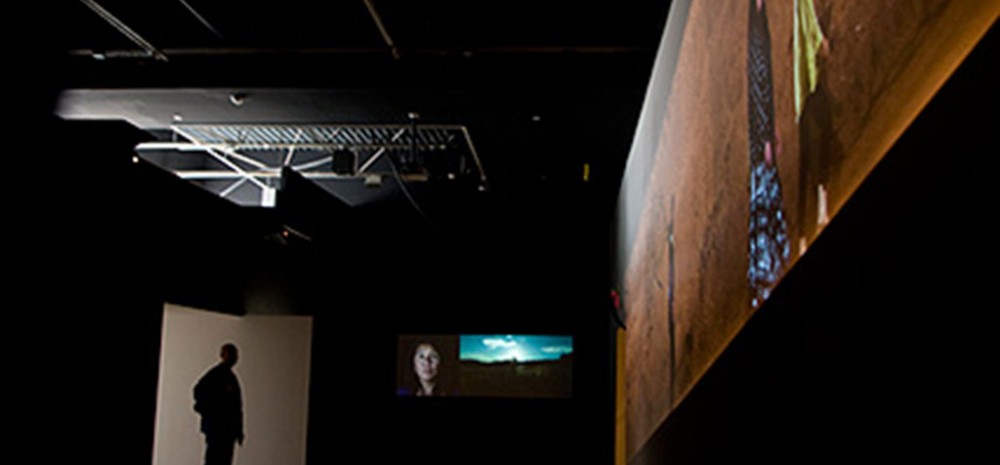Studio Azzurro
The Fourth Ladder, 2008
The enormous spread of communication systems has generated new ways of getting in touch with people and things. We are aware of the fact that a high potentiality of connection corresponds to a low ability of relation. Our relationships always become more self-interested and transient, they pass through devices and procedures and our ways of communication get more chaotic and superficial. The huge size of our knowledge and the names that we transcribe on our laptops correspond to a more marked individualism that often flows into a dimension of loneliness. The large human heritage that consists of gesticulation, direct contact and time spent with someone, always gets more compromised by the media that doesn’t allow any familiarity.
The work we’re showing at the SITE Santa Fe Biennial, The Fourth Ladder, turns this process upside down and proposes to re-evaluate a more human attitude by the action of stopping a person from establishing an emotional and deep exchange. The intense gesture of stopping one of the many characters passing by and detaining him with your hand expresses the desire of contact. It shows the necessity of getting in touch: you can get into the closest of an individual experience as if it were a gift. It is also a nice action from the aesthetic point of view.
In this case the technological media still exists  the technological device generates the characters and their reactions  but its presence is not the aim, it is not the procedure. The device represents a means to amplify the emotion, as it generates a renewed sensory experience.
For years we have been interested in the new technologies that in the last decades have revolutionized the human behaviour and imaginary, and we’ve always observed these technologies through the artistic way of seeing. So we “desecrate†the technological device by setting free those aspects, which have been imprisoned, and we give them back as a common value. Above all we’d love to invite our interlocutors to share our experimentations by the interactive systems and the sensible environments. We look for a dialogue with no guidelines or procedures, a dialogue that includes only the spontaneous actions of the interlocutor. The behaviour can revel spontaneous and true reactions, as the tracks and the choices stored in the electronic memories are composed of emotional stratifications that can potentially let the work evolve.
We also want to immerse ourselves in the territory. We experienced this attitude in 2002 with a set of works named Mediterranean Meditations. We observed the geographic territory of the region and above all the anthropological one. We think that nowadays this aspect should be important to any artistic experience that cares about the state of the world. In this way we wish to make people aware of imagination, attitudes, and choices. In the beginning of the 20th century, the Impressionists realized one of the biggest revolutions in the ways of seeing with the en plein air technique. The Impressionists let the wind, the smells, the light, and the changing colours lead their paintbrush. We have to conceive techniques, systems, and devices between the movements of the people, in the evolutions of the narrations, in front of a sneer of hostility, or in front of a smile of hospitality.
We want to use the camera instead of the paintbrush to explore different conditions and historical resonances. So we’ll be able to pass these resonances homoeopathically using the technologies that have obscured them, and the audience can be the character and the actor of the work.
We want to get in touch with the native culture of the Pueblos and we want the fourth ladder to be the metaphor of the emersion from one world into the other one, to reach a purified and better condition, as it happens in the Kiva. We want our characters to continuously be walking by the screen to become bearers of time and human density. At the same time, the role of the observer can rest with expressive complicity because the value in our research remains in that density and in that role.
The Fourth Ladder is located in Gallery 3.
Paolo Rosa
Born in 1949 in Rimini, Italy
Stefano Roveda
Born in 1959 in Milan, Italy
Leonardo Sangiorgi
Born in 1949 in Parma, Italy
Studio Azzurro is an artistic research studio that bases its artistic expression on the language of recent technology. Founded in 1982 by artists Fabio Cirifino (photography), Paolo Rosa (visual arts and film), and Leonardo Sangiorgi (graphics and animation), the group expanded in 1995 to include Stefano Roveda, an expert in interactive systems.
For over twenty years, Studio Azzurro has been investigating the poetic and expressive potential of the technological systems that have irrevocably shaped our world and our relationship to it. Through its production of video and interactive environments, theatrical performances, and films, Studio Azzurro has blazed a trail that is now acknowledged worldwide by countless major artistic and theatrical institutions and events. In addition to their experimental work with technology and its relationship to architectural space and the human body, the group’s activities are also tied in with more formative experiences such as museum and exhibition design that speak broadly about the value of culture. These endeavours have also been recognized by local, national, and international audiences. Whether it is tackling experimental or established environments, Studio Azzurro has taken care to create communicative projects that require an active and significant participation on behalf of the spectator. Inspired by the use of a multi-textual approach to art and technology, Studio Azzurro considers the viewer an integral part of the narrative structure, and a mediator between the continuously shifting elements of the virtual and real.
Martina Mazzotta
